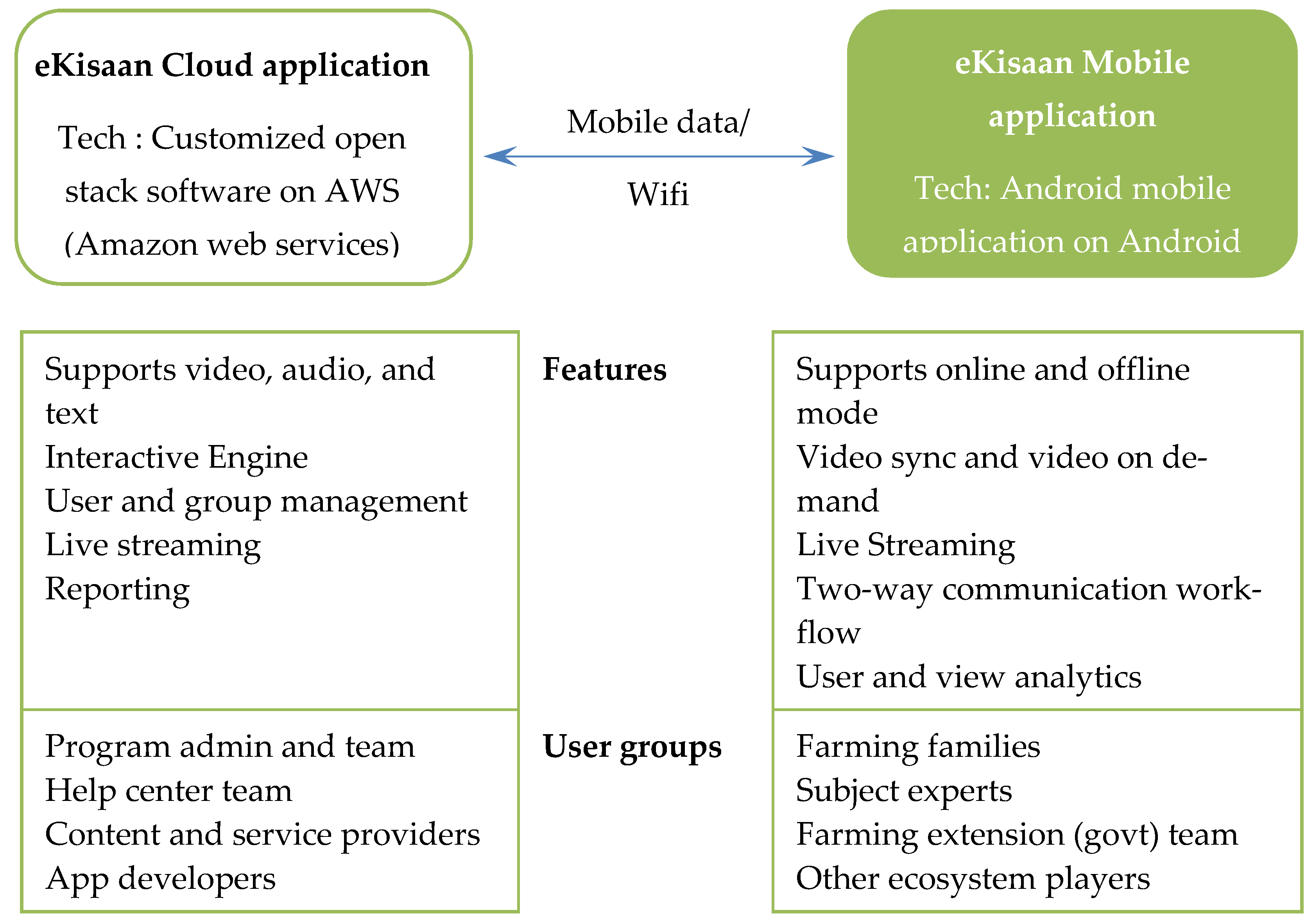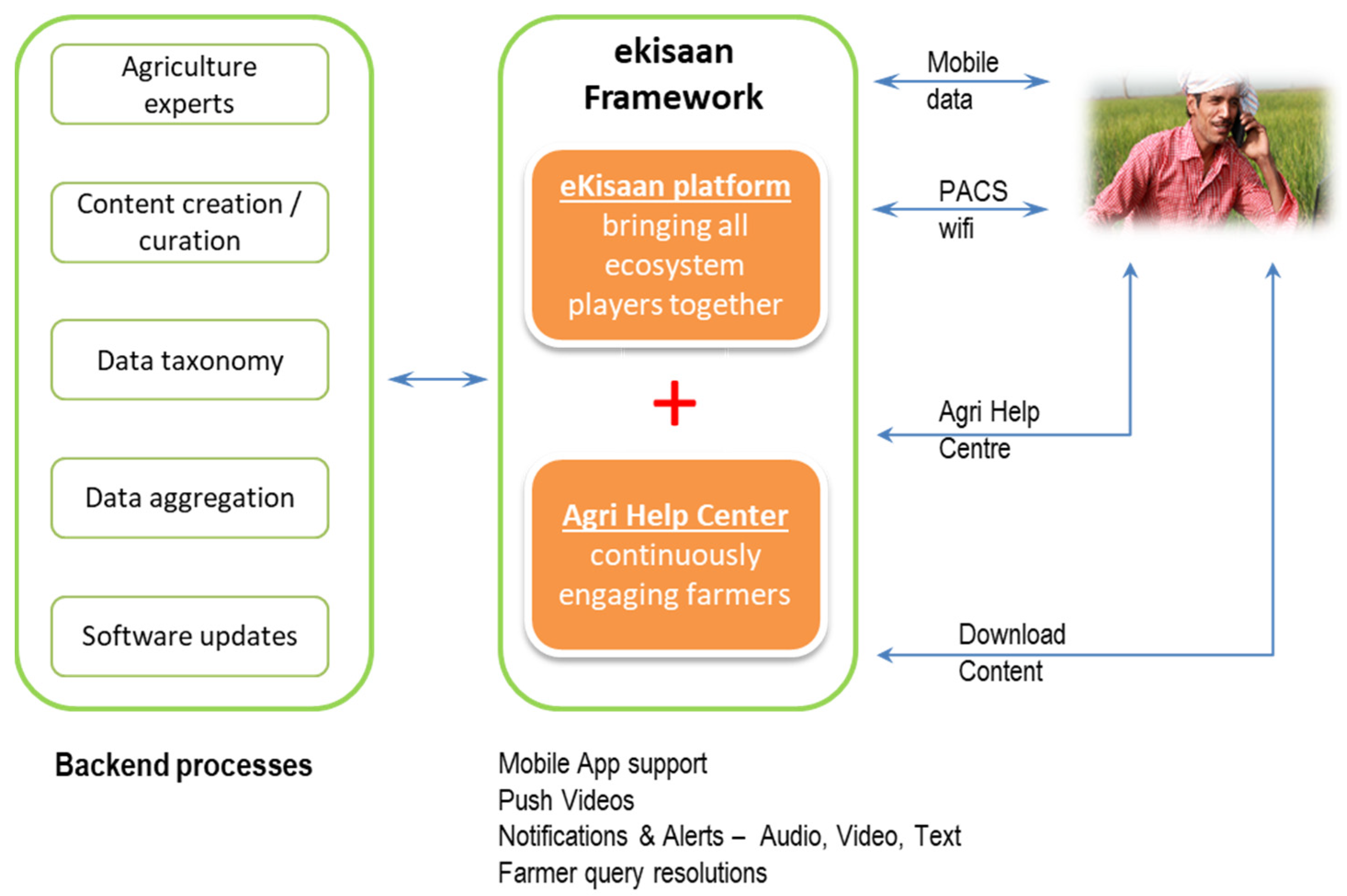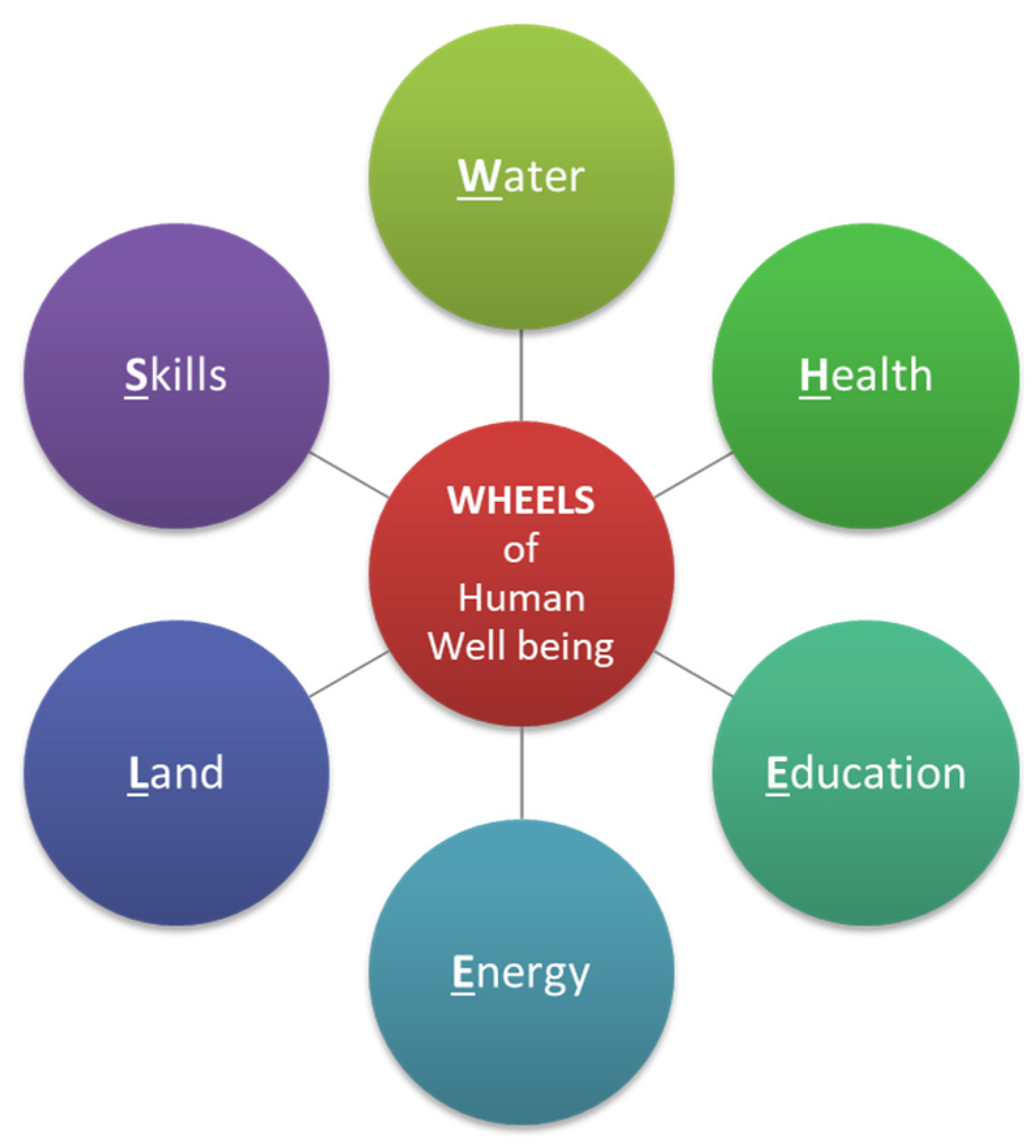1. Background
Since the formation of the Consultative Group for International Agriculture Research (CGIAR) about 50 years ago, agricultural research in populous developing countries has flourished. During the same time, the emergence and growth of national agricultural research systems (NARS), especially in China and India (which have most of the world’s farmers), have brought the outputs of research to hundreds of millions of farmers. Thus, the world’s food production rose from 3533 million tons in 1970 to 9863 million tons in 2019 [
1], keeping pace with growth of human population from 3700 million in 1970 to 7713 million in 2019 [
2].
Increases in food production have been accompanied by declines in agrobiodiversity, soil fertility, and water availability [
3,
4,
5]. Natural habitats and wild biodiversity that provide many ecosystem services to agroecosystems in the form of nutrients, water, pollinators, and predators of insect pests have also degraded [
6,
7]. Climate change, which has already started to impact agricultural systems, poses a new danger to agricultural productivity and human well-being [
8,
9].
COVID-19 has further exposed vulnerabilities of modern agricultural systems to the provision of nutrition and food security, the disruption of market chains, and (in countries like India) rapid demographic changes in villages due to abrupt increases in migration from urban to rural areas.
Thus, the information farmers need to sustain agriculture has tremendously increased: the maintenance of biodiversity and soil fertility, resilience to diseases, adaptation to changes in weather patterns, the mitigation of climate change, fluctuations in market prices and price support systems, and a whole host of related parameters.
New technologies engineered by the digital revolution offer unprecedented opportunities for innovating and sustaining agricultural ecosystems and associated livelihoods. Digital platforms can also become important sources of information on the local environment, health, and education. The two-way flow of information can, in turn, assist development planners in building local databases on demographics, mobility and human development indexes, aid the realization of Sustainable Development Goals (SDGs), and empower communities in fostering social capital and managing natural resources, thereby enabling sustainable agriculture.
Despite huge investment in CGIAR and NARS, there have been few systematic efforts to create digital platforms to meet the information requirements of farmers in a changing world [
10]. Ironically, in the urban world, every moment, we rely on digital information to sustain our lives and jobs. Here, we describe our experience with a simple digital platform that can serve farmers’ needs. The eKisaan platform was launched in 2015 in two districts, Bagalkot and Vijayapura, in the state of Karnataka, India. The platform has served more than 15,000 farmers in about 1000 villages.
We first describe the objectives of the platform, its functional details, and the information delivered to farmers. We then discuss the impacts of the platform along with constraints and associated solutions. We conclude by suggesting ways to scale up the platform as an information system, not only for agriculture but also for other sustainable development goals.
2. eKisaan—A Pilot
“Kisaan” means “farmer” in Hindi language. The eKisaan program was initiated in 2015 by the eKisaan foundation in partnership with four agricultural universities of the state of Karnataka that provided outreach teams, subject matter experts, relevant information, and guidance to farmer groups, with the intent of increasing agricultural productivity and income. This pilot was done for three crop cycles, giving encouraging results.
2.1. Program Goals
The general goals of this program were to test effectiveness of an interactive information system in real time to enhance the well-being of rural people and to foster sustainable use of resources. The specific goals for this project were to:
Increase yields, leveraging best practices and learnings from peer groups.
Reduce or optimize farm inputs.
Inform farmers about markets and government policies.
Enable digital literacy among farmers.
The long-term goal was to enhance rural income and eventually to also provide information about other aspects of agricultural and environmental sustainability, such as agrobiodiversity, water usage, and the local natural and semi natural ecosystems.
2.2. Delivery of Information to Farmers
Given that a large number of farmers are not aware of technology, a number of steps were taken to prepare them for accessing information on a daily basis.
First, farmer clubs were created at the village level to increase their engagement in the program—1300 farmer clubs across 1000 villages. These clubs received a customized and pre-configured internet-connected Android tablet with the eKisaan mobile app that was connected to the eKisaan platform for information delivery.
Second, a call-in help center was created to enable farmers (and representatives of farmer clubs) to connect with experts in real time. The help center team comprised eight people, all with agriculture backgrounds and had access to university scientists, agriculture experts, and progressive farmers to provide clarifications and guidance to the requesting farmers and farmer clubs.
Third, along with the help center, a digital platform (eKisaan platform) was created to deliver relevant and contextual information in the local language (mostly video) via mobile and cloud technologies. This platform included a two-way communication feature with the farmers that was extensively used during the growing season.
The digital platform also connected other ecosystem players, including academia, to leverage their knowledge and experience (
Figure 1).
2.3. Information Delivered to Farmers
The focus of information was on six commonly grown crops (cotton, maize, pearl millet (bajra), sorghum, sugarcane, and chickpea) in the two districts. The platform provided information about crop management and a variety of other parameters. Most information was updated daily to the cloud application to be accessed via the mobile app. The crop-related information included:
Relevant agricultural implements that can be used across lifecycle of various crops for that season.
Local soil composition (e.g., NPK).
Water condition (e.g., salinity and other chemical compounds).
Seed sources (e.g., native seeds and hybrid seeds).
Crop combinations for better outputs (e.g., intercrop combination for additional income).
Optimal use of water, fertilizers, and pesticides throughout crop lifecycle (sowing through harvesting phases).
Additional information provided included:
Weather forecasts.
Emergency alerts (extreme weather events and pest outbreaks).
Current market/yard prices.
Government schemes and subsidies.
Best-practice sharing from agricultural universities and other agencies.
Contact details of agricultural and support department.
2.4. Monitoring and Feedback
Some of our measures for effectiveness of the system were the lead time we took to respond to farmers and the time it took to resolve their questions, and these two parameters also served as the indicators of the usefulness of the platform along with the number of calls received by the help center. The feedback from farmers and field staff on the relevance of the provided information, as well as the assessment of additional needs of farmers, also helped fine tune the program.
In terms of lead time for information consumption, after the initial 4–5 weeks, more than 70% of farmer groups were found to access the information prior to 10:00 a.m.; the number increased to close to 100% by 7:00 p.m.
Initially, for the first three months, the resolution time for problems was about three days. This time was reduced to 24 h in subsequent months. Problem-solving required information from our database (from past experiences/info gathered), and connecting farmers with the appropriate experts, the extension staff of a government agency or university, or another farmer. Most resolutions (~75%) to farmers’ questions involved making outbound calls to farmers to close the loop. Outbound calls from help center created trust and loyalty.
For the first two months, the call volume was high. Subsequently, calls averaged to 120 calls per week. Repeated questions (see
Appendix A) across farmers helped identify relevant content, and it was pushed to farmers the following day. The type of calls/questions received by the help center was also a measure of farmer engagement and feedback from farmers. The views on videos sent (~12 per week) to farmers was another measure of engagement. The average number of views of each video sent was five per farmer group.
Daily contact by the help center team with farmers, and the field staff, also provided valuable inputs for fine-tuning the program in terms of providing right content and support from relevant experts. Open-house sessions with experts and progressive farmers, coordinated by multiple farmer clubs, comprised question and answer sessions.
2.5. Impacts
The assessment of impacts was based on non-random sampling of individual farmer-clubs and conversations with a number of farmers. The absence of a systematic evaluation and monitoring plan was one of the weaknesses of the program, but it was made up by feedback from a large number of farmers.
After 18 months, the help center reached out to over 650 farmer clubs (out of 1300 clubs) and 2000 farmers (out of 15,000 farmers) to assess the impact of the program in terms of their incremental savings from reduced inputs and increase in earnings from enhanced productivity. These average figures amounted to INR₹2250 and INR₹3000, respectively, based on the feedback from farmers and farmer clubs. The combined amount of ₹5250 represented a 15% increase in the average annual cash income of ₹35,000. In the third year, a limited sampling of 200 farmers indicated a further increase of 7%, bringing the total to 22%.
Assuming that only one-third of the farmers got this increase, i.e., 5000 out of 15,000 farmers, the total incremental savings then were INR₹11,250,000 (INR₹2250 multiplied by 5000 farmers), and the total increase in earnings was INR₹15,000,000 (INR₹3000 multiplied by 5000 farmers). The combined figure from incremental savings and incremental earnings, based on a conservative figure of only 15% (after 18 months) rather than a total of 22% increase by the third year, was: INR₹26,250,000 or INR₹5250 per farmer. The approximate cost of the information technology program and help center was INR₹15,000,000. These costs did not include the time devoted by fifteen volunteers over a three-year period who spent an average of sixty hours per month on program managing, serving the information system and answering questions.
We believe that even by considering the time devoted by volunteers, the monetized benefits exceed the costs, especially when the environmental benefits associated with reduced inputs (which we did not quantify) are monetized. These environmental benefits accrue from the reduction in cost of manufacture and transportation of pesticides and fertilizers and the decrease in flow of such compounds in water supplies. Furthermore, the benefit–cost ratio should also increase over time. Moreover, the same information system could serve thousands of more farmers and could provide a variety of other services (see below), thereby increasing cost efficiencies.
On the social interaction front, as a part of this pilot project, we saw increased interaction and engagement among farmers in the open-house sessions: interactions with the subject matter experts and, importantly, among themselves. The platform may also have catalyzed horizontal transfer of information among farmers. Furthermore, there is anecdotal evidence that the platform led to greater collaboration among farmers in pooling their resources for composting and creating seed banks.
2.6. Challenges and Solutions
Several constraints and challenges were overcome during the project period.
First, the two districts have low literacy rates. Few farmers could read and write with ease. Thus, we designed the mobile app with visual elements rather than text elements. In addition, the content was provided as video or a visual image with audio.
Second, since we were targeting 15,000+ farmers for this program, the farmer count posed a challenge for providing effective training in a short span of time. We overcame this challenge by adopting a train-the-trainer model. We trained 400 college students in these two districts, and they, in turn, trained the farmers (see
Appendix A). These students then continued to be the point contact for first two months. This also brought in a sense of ownership among students and farmers.
Third, providing usable visual content in the local language to farmers for their specific crops during crop’s life cycle stage was a challenge that was overcome by partnering with four agricultural universities in the state of Karnataka to get relevant and useful visual content, as well as responses to farmers’ questions on a daily basis.
Fourth, sustained farmer engagement was fostered by a three-step process: (a) making all delivered audio–visual, with minimal text, relevant to the crop life cycle; (b) following up every question asked by the farmers with an outbound call to the farmer; and (c) showcasing success stories (via the mobile app) from within the farmer groups.
Finally, during the project time, the mobile data network coverage was patchy and the data costs were high for the farmers. Given the number of the farmers we were reaching, this challenge had to be sorted out. We partnered with a mobile service provider to get free data for the duration of the program.
In addition, the factors responsible for the program success were timely and relevant content; the use of mobile handheld devices; outbound calls to farmers (call back); and focused collaborations among the farmers, technical team, and agricultural experts.
2.7. Extending the Platform to Farming Ecosystem
Apart from agriculture, the same digital platform could be used to provide information about other aspects such as water, health, education, energy, land and livelihoods, and skills. We coined an acronym, WHEELS, that encompasses the needs of a farming ecosystem (
Figure 2). Land includes agriculture, soils, and biodiversity. Perhaps no name can capture the value and use that such an information system can provide, especially in a COVID-19-dominated or a post COVID-19 world.
Connecting society with knowledge, information, and technology is key to enable sustainable development, maintain integrity, and even augment natural assets. An eKisaan-like platform (
www.ekisaan.com Accessed on 28 April 2021) could plug into the societal platforms (like
www.societalplatform.org Accessed on 28 April 2021) aiming to achieve broader sustainability goals.
The platform could be fine-tuned to allow all segments of society to share data and information that foster the welfare of a state and its people. We plan to extend this platform to accommodate other regions and geographies. Enhancements can be made for information integration with external sources. At the same time, there is scope for enhanced analytics that are customized to even more “local” needs. Information needs and usage should drive the kind and amount of information to be served. We are also working to make the mobile app ‘open access for all’.
3. Concluding Remarks
As in any domain, data and technology interventions can help achieve sustainable development goals. We have seen here that information systems focused on agriculture can increase productivity and income while conferring environmental benefits in the form of reduced inputs of fertilizers and pesticides. Such systems are cost-effective. Scaling up to include more farmers could further reduce the unit costs of the platform. Adding other types of information could increase benefits.
One may argue that increases in income (22% over three years) have been nominal. However, it is important to note that a primary goal was to develop and test an information system, and to demonstrate its cost-effectiveness. Information coupled with interventions such as improved digital literacy, soil and crop management, increases in crop diversification, better control of diseases, enhanced market access, and efficient market linkages could further increase income. Thus, with rather simple steps, the Government of India’s goal to double farmers’ income should be achievable.
An eKisaan type of platform could also enhance communication among multiple stakeholders (see
Figure A1), making agricultural research and extension truly participatory. Though the call for eKisaan-like platforms is old [
10], the development and testing of such platforms to foster sustainability is very recent. We know of no other examples of such platforms, but we are certain that comparable platforms will be developed in the immediate future.








